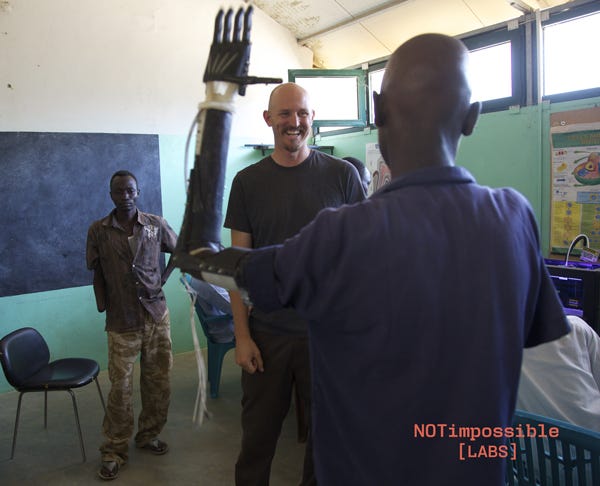A hospital in the war-torn Nuba mountains region of southern Sudan is probably the last place you would expect to find a 3D-printing lab for prosthetic devices and an associated training facility. There is little infrastructure, no running water, and electricity is a luxury. But thanks to the Not Impossible foundation based in Venice, CA, the lab is up and running, and has already transformed the life of 16-year-old Daniel, whose arms were blown off when he was 14.
February 3, 2014
A hospital in the war-torn Nuba mountains region of southern Sudan is probably the last place you would expect to find a 3D-printing lab for prosthetic devices and an associated training facility. There is little infrastructure, no running water, and electricity is a luxury. But thanks to the Not Impossible foundation based in Venice, CA, the lab is up and running, and has already transformed the life of 16-year-old Daniel, whose arms were blown off when he was 14. He received a 3D-printed prosthetic arm in November 2013, and was able to feed himself for the first time in two years.
Not Impossible is the brainchild of Mick Ebeling, a film and commercial producer and founder and CEO of The Ebeling Group, an international production company and think tank representing design and director collectives. Not Impossible first gained international recognition in 2010, when it's Eyewriter eye-tracking glasses enabled a paralyzed graffiti artist to draw using only his eyes. Eyewriter was named one of the top 50 innovations of 2010 by Time magazine. Project Daniel is the second major undertaking of the foundation, and it led Ebeling to leave the comfortable climes of Southern California for South Sudan, 9000 miles and a world away.
|
Mick Ebeling of Not Impossible and Daniel with his new prosethetic arm. |
"This was my first time in South Sudan, and the conditions were extreme," says Ebeling. "I was at a refugee camp in Yida, which the United Nations calls the harshest and most difficult refugee camp in the world." But the beautiful thing about a location like that, says Ebeling, is that "by 3D printing arms there, we proved we could make them anywhere."
Ebeling and his team set up the 3D-printing lab in a room at Mother Mercy Hospital in the Nuba mountains. The local population has been victimized by a scorched earth campaign waged by Sudanese president Omar al-Bashir, purportedly to root out members of the Sudanese People's Liberation Army. Conditions are primitive, compounded by what has been dubbed a forgotten war. "The hospital had solar-powered electricity that was on a back-up battery system," says Ebeling. "There's limited infrastructure in the town, no tapped running water-only a bore hole-and no consistent source of electricity."
Dr. Tom Catena assisted Ebeling's team in fitting the prosthetic arm to Daniel using ultrahigh molecular weight polyethylene, sold by Orthoplastics, and teaching hospital personnel how to print and assemble 3D prosthetics. Medical expertise is not required to print the prosthetic devices, says Ebeling. "I am not a medical professional, and I was able to build multiple arms. It's a question of understanding comfort, so that the Orthoplastics [material] fits on the amputee's stump. If it's not comfortable, the person won't wear it. It has more to do with logic and physiology than any kind of specific medical training," explains Ebeling.
To get Project Daniel off the ground, Ebeling crowdsourced a team of innovators that included Richard van As, the South African inventor of the Robohand who is a story unto himself; a neuroscientist from Australia; and a 3D-printing entrepreneur from Northern California.
Precision engineering company Precipart (Farmingdale, NY) provided financial support for the trip, and continues to play a significant role in the project. "Precipart is supporting our ongoing efforts to create high-quality hardware at the cheapest possible cost so that the arms become accessible to more people in more places, as we take Project Daniel 2.0 to other countries," says Ebeling. Intel also provides support, and promoted the project at its stand at the 2014 Consumer Electronics Show in Las Vegas in January.
"My belief is that all technology serves a purpose, and I see 3D printing as serving a very specific purpose of being able to print prosthetics," says Ebeling. By showing that you can teach 3D printing to people who are barely familiar with computers in a way that can dramatically improve their lives should resonate with people in other parts of the world, he adds. "We're hopeful that children and adults in other regions of Africa, as well as other continents, will use the power of this new technology for similar beginnings," says Ebeling.
Meanwhile, the seeds that Project Daniel planted at Mother Mercy Hospital are bearing fruit. By the time Ebeling had returned to the United States near the end of last year, local trainees had successfully printed and fitted two more arms.
The sad truth is that they will need to print many more.
About the Author(s)
You May Also Like





